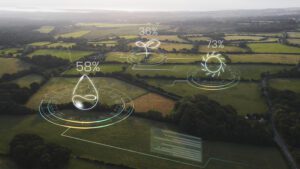Digital agriculture integrates digital technology into livestock and crop management and other processes related to cultivating and managing food resources. The term is often used to describe the different uses for the variety of data collected in this sector. But it’s also about how technology integrates and works throughout the supply chain, from seeds or farm animals to the consumer. Farming has come a long way since the invention of the plow, and later innovations like the tractor combine to improve agricultural productivity using digital farming solutions.
Digital agriculture, often called ‘smart farming’ or ‘precision agriculture,’ is an innovative approach to farming that uses modern technologies to enhance agricultural practices. The idea is simple: instead of relying solely on traditional methods, we integrate digital technologies.
Grasping the Universe of Digital Farming Solutions
Precision agriculture is a precise form of digital farming technology. GPS (Global Positioning System) is a positioning device instrumental in precision agriculture applications. State-of-the-art technological practices pave the way for yield mapping, yield supervising, variable rate methods, and vehicle navigation. Precision farming originally empowered farmers who longed to evaluate field yields accurately. Significant numbers of tractors these days come with GPS.
How is the adoption of digital farming taking place?
McKinsey analysts have described the world’s food producers as the “least digitized industry.” But this means the agricultural industry is ripe for disruption. Here are a few ways digital farming solutions are beginning to transform the agricultural industry.

1. Robotics
The latest generation of farmers are now deploying robots to not only plant and pick crops and feed and slaughter livestock, but to also further optimize other practices like weeding and cultivating. The current market for agricultural robotics is worth over $5 billion, and it’s expected to double in the next five years.
2. IoT and Sensors
Using the Internet of Things (IoT) and sensors, farmers can track live animals and produce, evaluating environmental factors as well as the health of livestock. This provides farmers and partners with real-time visibility throughout their operations.
3. Artificial Intelligence
Much of farming to date is based on trial and error or knowledge passed down from people with a deep understanding of the industry. This creates challenges for new entries to the industry, which must undergo a lot of costly errors. Artificial Intelligence (AI) can be an incredible asset for veterans and new farmers. It can help these professionals quickly get the information they need and avoid inefficiencies.
4. Drones
Drones have become incredibly common in the agricultural industry. In China, they are being used to survey 20 million hectares of cotton crops, observing things that humans on the ground may not be able to see. Drones can provide insights about harvest timing, irrigation, pest protection, etc.
5. Cloud Connectivity
Cloud-based connectivity uses real-time internet connection to offer farmers more flexible digital solutions and economies of scale. Many farmers need to be connected. So adopting cloud connectivity is a massive upgrade, where farmers can see and accomplish more in real-time.
6. Data Analytics
By 2025, the world will store 175 zettabytes of data. That’s a lot of information to digest. Fortunately, some innovators are creating robust solutions that help those in the agricultural industry collect, store, and make sense of data.
Benefits of Digital Agriculture
A digital farm is far more sustainable and efficient than a traditional one. Bringing technology into the agricultural sector involves various strategies, including artificial intelligence, the Internet of Things, mobile technologies, and other digital solutions. Some of the many benefits that come with digital agriculture include:

1. Streamlined Communication
Automated workflows have become invaluable for teams in the agricultural industry. Data must be collected manually, delivered, and then processed using paper forms and antiquated spreadsheets.
With automated data collected through technology like RFID tags and other mobile computing solutions, agricultural data can be easily gathered in the field and sent instantly to management and other supply chain partners. This improves operational efficiency and creates more visibility throughout the food supply chain.
2. Effective Monitoring
Digital farming technology can allow farmers to better monitor the health of their livestock and crops. Tools such as wearable sensors for livestock can monitor temperature, and drones are now being used to survey fields, assess soil quality, and plant seed planting patterns. Farmers can employ animation to predict the success of various strategies. These solutions also help them manage and monitor weed and pest activity throughout their operations.
3. Better Documentation
When farmers produce food that ends up on consumers’ tables, they must document everything to ensure traceability for the consumer. This is a highly regulated industry. But manual forms don’t allow for digital attachments, making the entire process more tedious and time-consuming than necessary.
Farmers can fill out, and file required forms directly from their mobile devices by digitizing their operations. Forms can include captured GPS coordinates, allow for photo and video uploading, and even digital signature boxes.
4. More Informed Decisions
Thriving agriculture is based on a series of correct choices — when to plant crops, how to plant them, when to harvest them, which partners to work with, what prices to charge, etc. Digital technology gives farmers detailed insights to understand better their performance and the information they need to make more informed decisions.
It’s also important to note that more data is available than ever before, making it nearly impossible to interpret what’s collected without help. Agricultural companies can now leverage Big Data to solve issues or prevent problems concerning planting, harvesting, selling, and transporting crops.
5. Save Time and Money
One of the biggest drivers for embracing digital agriculture is its ability to save farmers time and money. By laying out a field more effectively using GPS technology and advanced insights, a farmer can increase their yield and get the job done faster, thus reducing costs.
Of course, most technology solutions come with a price tag. But those upfront costs can be quickly recouped as farmers realize the time and cost savings associated with greater efficiency and better visibility.
While digital farming technology is still in the pioneering and innovation stages, many businesses connected to this industry have begun to take note. Over the past several years, supply chain challenges have prompted companies to invest in digital upgrades like automation, RFID tracking, mobile computing, and wireless infrastructure. These investments will improve efficiency, increase visibility throughout the supply chain, and boost overall results.
For more details on digital farming, get in touch with the experts at SoilOptix® now!
